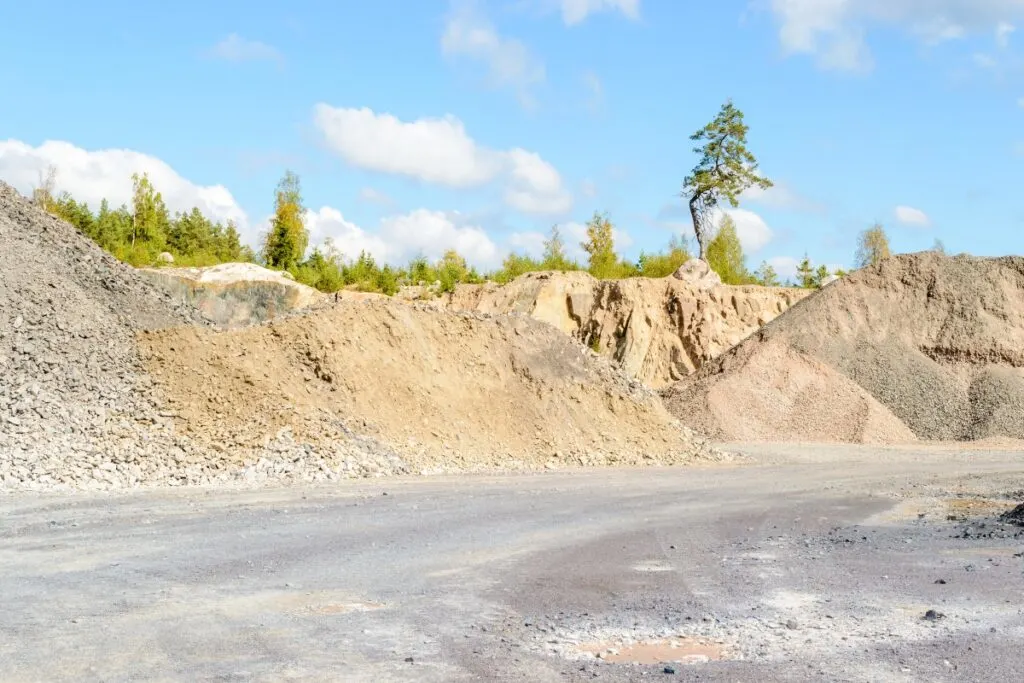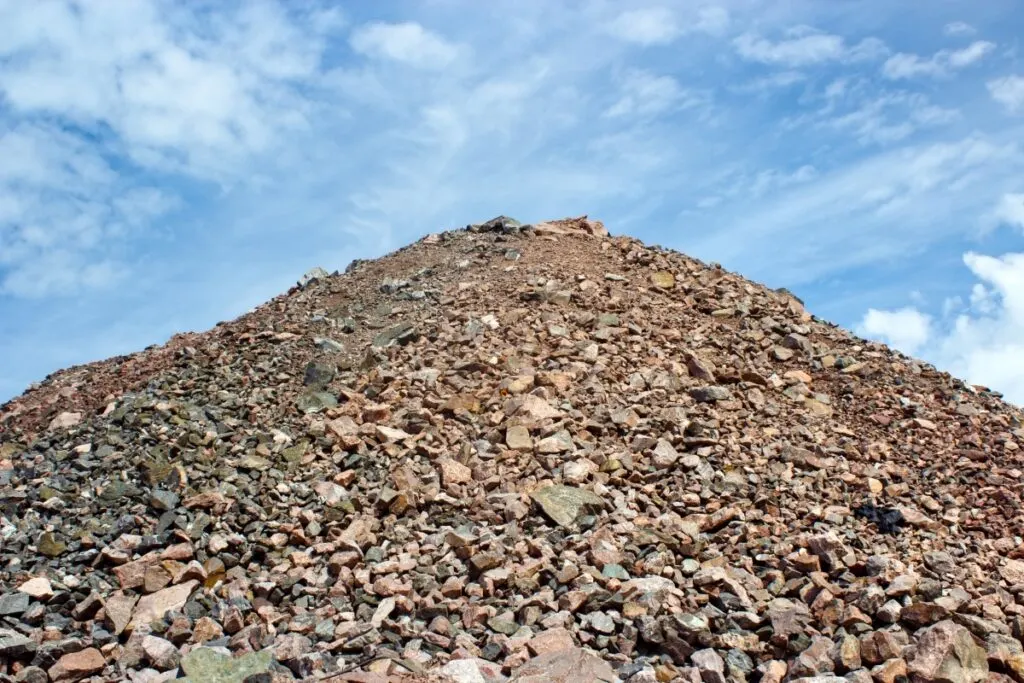As an Amazon Associate, I earn from qualifying purchases with no additional costs for you.
Rockhounds have many mediums and environments to collect rocks, minerals, gemstones, or even fossils. The best places to find fantastic specimens are usually within mines, quarries, or gravel pits.
One of the main differences between gravel pits, quarries, and mines is what you can find in them, who is allowed access, how you can gain access and other things. In most cases, the differences between gravel pits, quarries, and mines are trivial, but you should know them if you want to find what you seek.
Without further ado, let’s see what a mine, pit, and quarry are, what you can find in them, and the differences between them!

If you are interested in checking out the best rock and mineral identification books, you can find them by clicking here (Amazon link).
What are Gravel Pits, Quarry, and Mines? Short Explanation
Without question, as a rockhounding enthusiast, you might have encountered a mine, pit, or quarry in your travels. They might look similar and feel different, but what exactly sets them apart?
A pit is a hole in the ground that may contain tunnels or underground spaces. A mine is also a pit but has active or inactive buildings and operations above or below the ground, such as towers, processing conveyors, repair shops, etc. On the other hand, a quarry is an area where materials are excavated from the ground.
Let’s compare these environments directly and see what sets them apart and what you can find in them!
Difference Between Gravel Pit and Quarry
Gravel pits and quarries are both excellent mediums for rockhounds. The main difference between these two environments is that an open pit can be referred to as a mine if it produces building materials.
In gravel pits, apart from gravel, you can also find sand and rock fragments or whole specimens such as agates, jasper, agatized wood, quartz crystals, or even gemstones. On the other hand, quarries are large deep pits where you can find a much more versatile array of rocks, minerals, gemstones, or crystals.
For example, you can find certain specimens in quarries, such as diamonds, fossils, calcite crystals, pyrite, Lake Superior agates, tourmaline, barite crystals, and many minerals.
Another critical factor that sets quarries from gravel pits apart is that a quarry can’t exist in an area where there is nothing worth digging for. Through that extensive digging, you have access to essential strata otherwise unavailable.
On both these collecting fields, you will need permission or a permit to rockhound from the landowner or public authority.
BTW: Do you want to know more about rock and mineral identification? The books listed below are the best ones you can find on the internet (Amazon links):
- Smithsonian Handbooks: Rocks & Minerals
- Gemstone & Crystal Properties (Quick Study Home)
- Ultimate Explorer Field Guide: Rocks and Minerals (National Geographic Kids)
Difference Between Gravel Pit and Mine
Gravel pits and mines may also be confusing because large open pits can be referred to as mines if minerals are extracted from there. However, just like in the gravel pit and quarry comparison, there is a big difference between them.
No matter their size, Gravel pits can’t compare to real mines regarding their rocky, mineral, fossil, and gemstone content. This is because when you consider mines, you also have to consider all those extensive man-made underground tunnels and underground spaces that aren’t so accessible.
When you have access to the lower fields, you also gain access to a broader range of specimens that you would otherwise not be so fortunate to find. Besides, mines usually also have mining dumps right next to them.
Mining dumps are precious areas for rockhounds because you can find precious items even here. What makes them great is that they are accessible, but only if you have permission to collect them there.
Another critical distinction between mines and gravel pits for rockhounds is that many mines are available, even for small fees.
In these specially designated rockhounding areas, you are guaranteed to find whatever it is you are searching for, which might include geodes, quartz crystals, or gemstones, among many other things.
There is also a certain versatility to mines and mine dumps. Some are near mountains, others are near deserts, and their contents may vary drastically. Whatever the case, it is clear that mines and mine dumps are more rewarding for rockhounds than gravel pits.
TIP: There are many ways to find gold, from panning in rivers to using high-tech tools to help you find gold. Check out the complete guide on starting gold prospecting in the article below:
Ultimate Beginner’s Guide: How To Start Gold Prospecting
Difference Between Quarry and Mine
Moving on to our last comparison, quarries and mines! Both these mediums are undoubtedly among the best locations possible for rockhounds. They are exceptionally rewarding if you know what you are looking for.
The main difference between quarries and mines is that mines are like a hole in the underground layer and focus mainly on finding and retrieving minerals and other valuables from the earth. In contrast, quarries are similar to a mine but are situated on the surface levels of the earth and deal mainly with rocks, minerals, and sand.
Queries mainly deal with the bulk extractions of a commodity, delivering hundreds of thousands of tones of various materials. In contrast, mines deal with the targeted extraction of a commodity and may produce even ounces of some material.
In the U.S., there are over 3,000 quarries active today, but when it comes to mines, there are around 13,000 active. As previously mentioned, you need a permit to access these locations, but in other cases, you can enter and even collect at will for free or by paying a small fee.
The best thing about mines is that you are more likely to find something of note. In mines, you can find just about anything, from precious minerals such as gold, silver, or platinum, to gemstones such as diamonds, sapphire, amethyst, topaz, aquamarine, tourmaline, and more.
Active or abandoned mines, along with their mine dumps, are just as fruitful. However, it can be arguably said that abandoned mines are a bit more dangerous to enter than quarries. In regards to quarries, rockhounds shouldn’t dismiss them just because rocks are predominant there.
You can also find precious minerals, gemstones, or crystals in quarries. It all depends on where the quarry is and what was unearthed there. In many instances, even fossils were discovered on such sites.
TIP: Gemstones are rare treasures that can be found in natural environments around the world. Check out the ultimate guide to finding gemstones in natural rivers and creeks in the article below:
8 Tips On Finding Gemstones In Nature (Rivers & Creeks)
Best Pits, Mines, and Quarries to Rockhound in the U.S.

There are several famous pits, mines, and quarries where rockhounds can fulfill their wildest wishes in the U.S. Even though there are hundreds of areas to explore, let’s analyze a couple of the best spots!
Best Pits For Rockhounds
Gravel pits are easy to find in many U.S. states. For example, in Mississippi, the gravel pits east of Wesson have petrified wood specimens, along with banded agates and chalcedony.
In Missouri, you can find barite crystals at the gravel pits near Versailles, or you can visit New Jersey, where amber is commonly found in gravel pits, such as the one near Crosswick’s Creek, for example.
In Minnesota, Lake Superior agates, iron minerals, the famous Mary Ellen jaspers at the Mary Ellen Pit, near Biwabik, or the Corsica Pit.
In Texas, you should visit the gravel pits near the Rio Grande to unearth the famous Rio Grande agates and jasper or agatized wood specimens.
Best Mines For Rockhounds
We have the Crater of Diamonds State Park starting in Murfreesboro, Arkansas. Rockhounds have the highest chance of finding real-life diamonds and keeping them at this mine.
One of the most significant specimens ever unearthed by an enthusiast occurred in 2015 when an 8.52-carat diamond was found. Other minerals, rocks, and gemstones can be discovered here, but diamonds are the most abundant.
Near Hiddenite, another one of the best U.S. mines for rockhounds is situated in North Carolina, namely the Emerald Hollow Mine. At this mine, enthusiasts can find the rare hiddenite gemstone, emeralds, and quartz, apart from other specimens.
Rockhounds can visit and collect specimens at the Morefield Mine in Amelia County, Virginia. Visitors can find amazonite and 80 other beautiful types of gemstones and minerals. This mine is 300 feet underground, stretches over 2,000 feet, and continues to grow today!
BTW: If you are looking for the best UV light for rockhounding, find out my picks below (Amazon links):
- BEST OPTION: Convoy 8+ 365nm UV LED Flashlight with Patented Glass Filter
- BUDGET OPTION: Karrong Rechargeable 1200 Lumen 395nm UV Flashlight
- OPTION FOR INDOOR USAGE: Prime Upgraded Big Chip 396nm UV
Best Quarries For Rockhounds
The Trilobite Me Quarry in Delta, Utah, is among the best quarries for rockhounds in the U.S. due to its fossil collection. Visitors must pay a small fee to enter and collect their prizes. High-quality trilobite fossils of various sizes can be found here, among other things.
The Fayerweather Quarry near Prairie du Chien in Wisconsin is another excellent quarry for enthusiasts wishing to find high–quality geodes.
The Pingree Ledge, Bumpus, and Scribner Ledge quarries in Maine are filled with various minerals and crystals such as rose, smoky or milky quartz, almandine garnets, aquamarine, or golden beryl.
Conclusion
Gravel pits, quarries, and mines have advantages and disadvantages; however, as a rockhound, you shouldn’t dismiss any of these environments because you never know what you might find.
Make sure that the areas you visit are safe, and acquire the necessary permits beforehand if you want to find something specific, research and head to the best places! Don’t forget to gear up for the occasion as well! Happy hunting!
TIP: Modern geological methods of mineral identification are far more complicated than people used to think. Find out more about these identification methods in the article below:
Modern Methods of Rock & Mineral Identification (by Expert)
